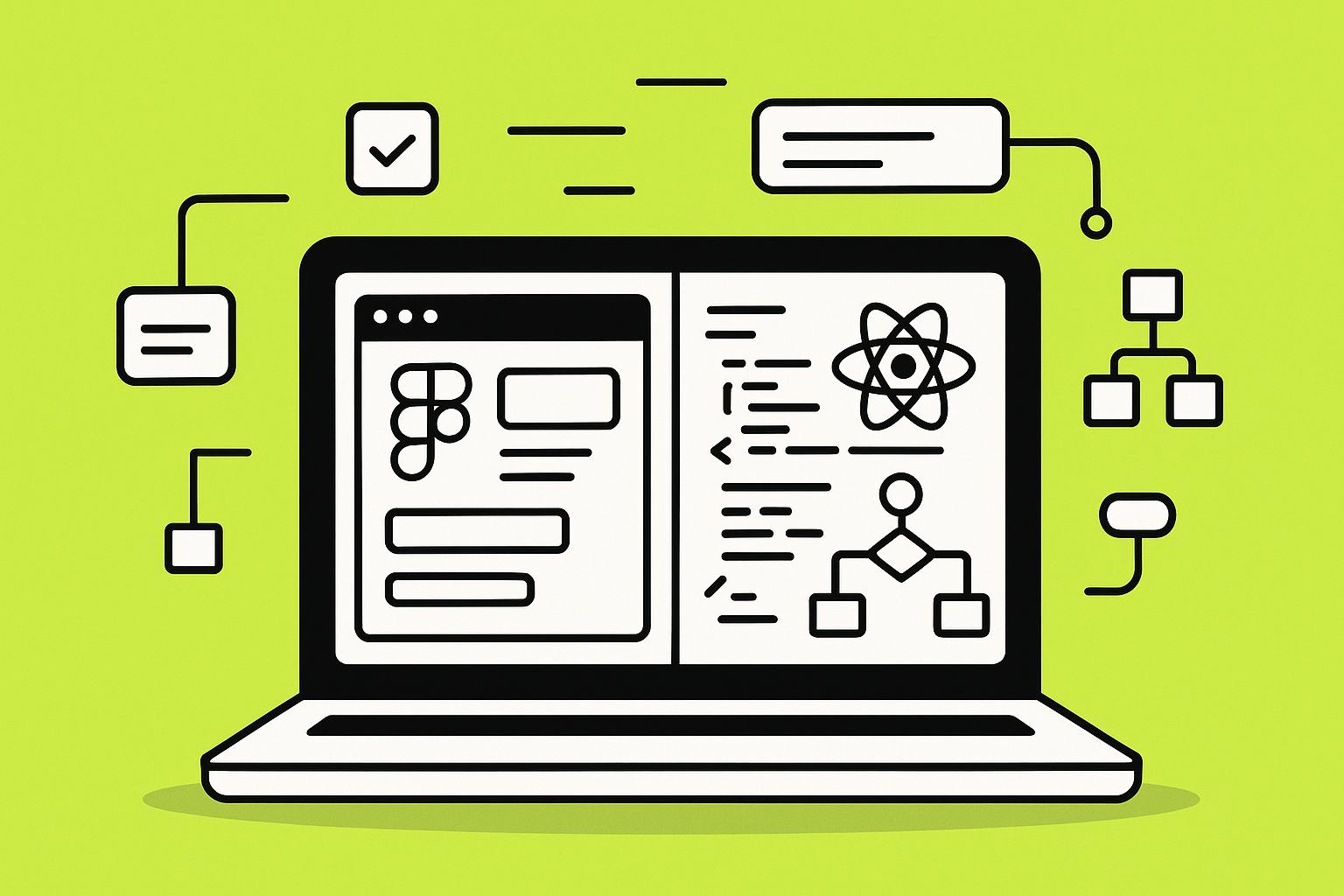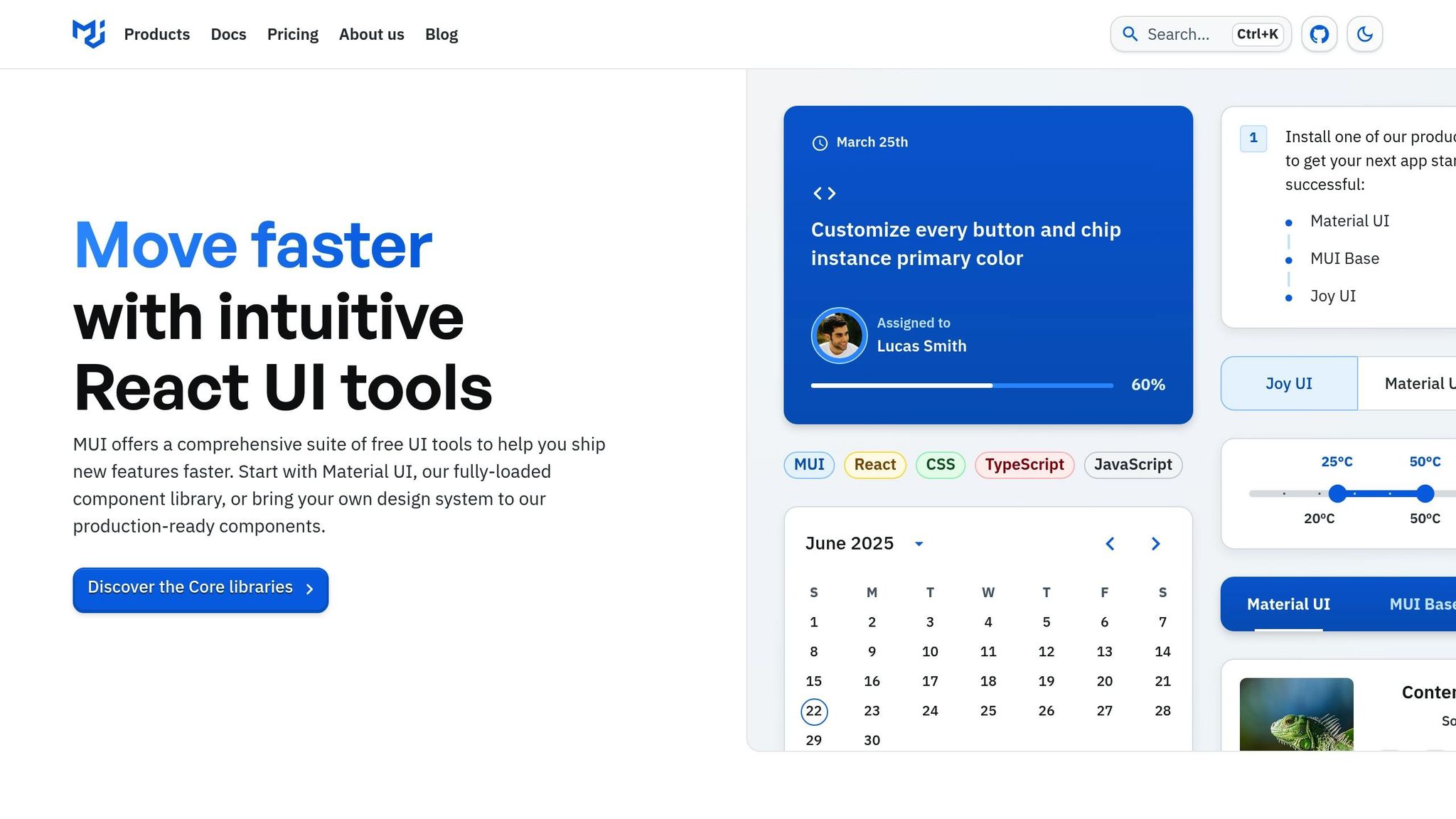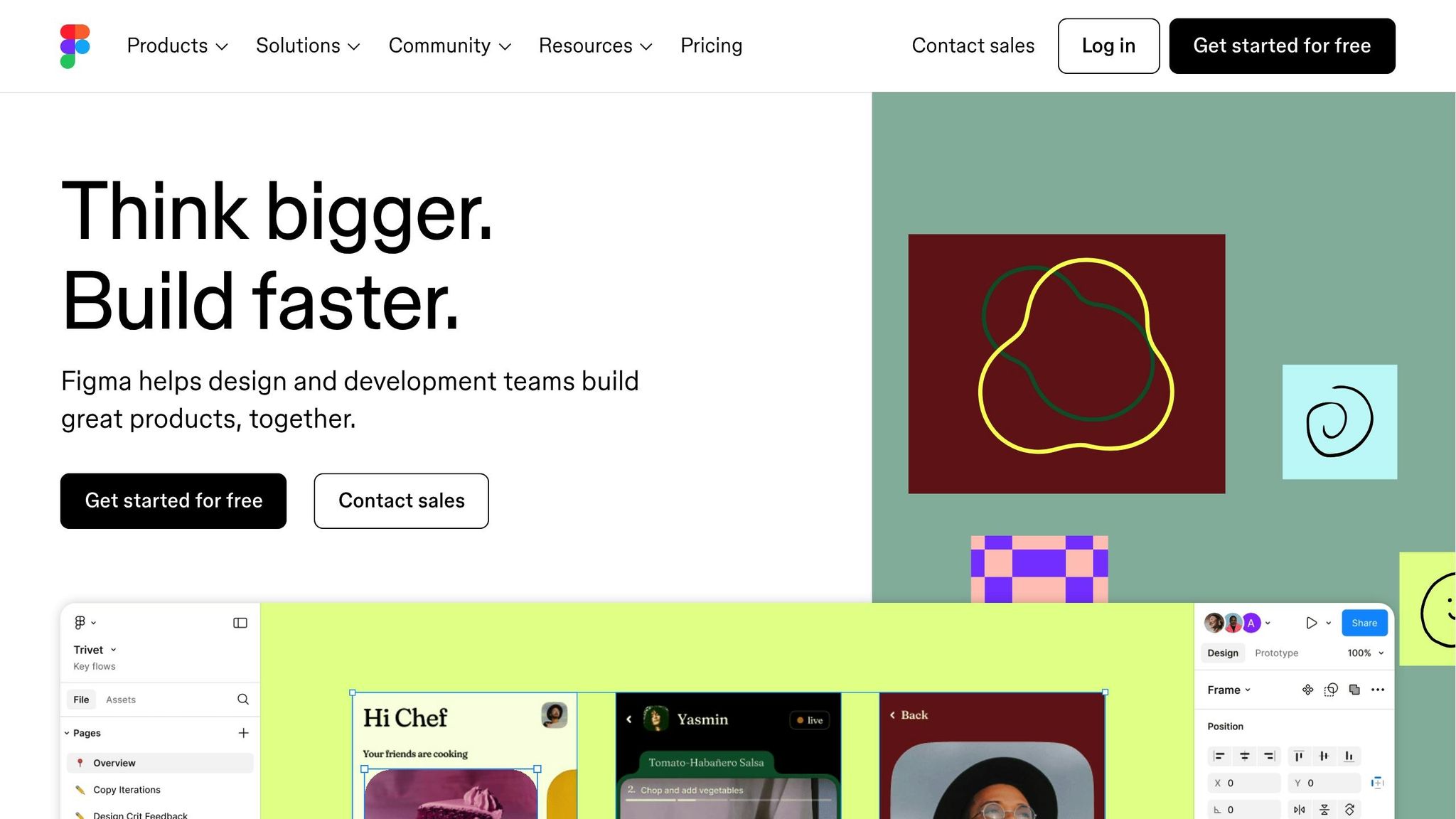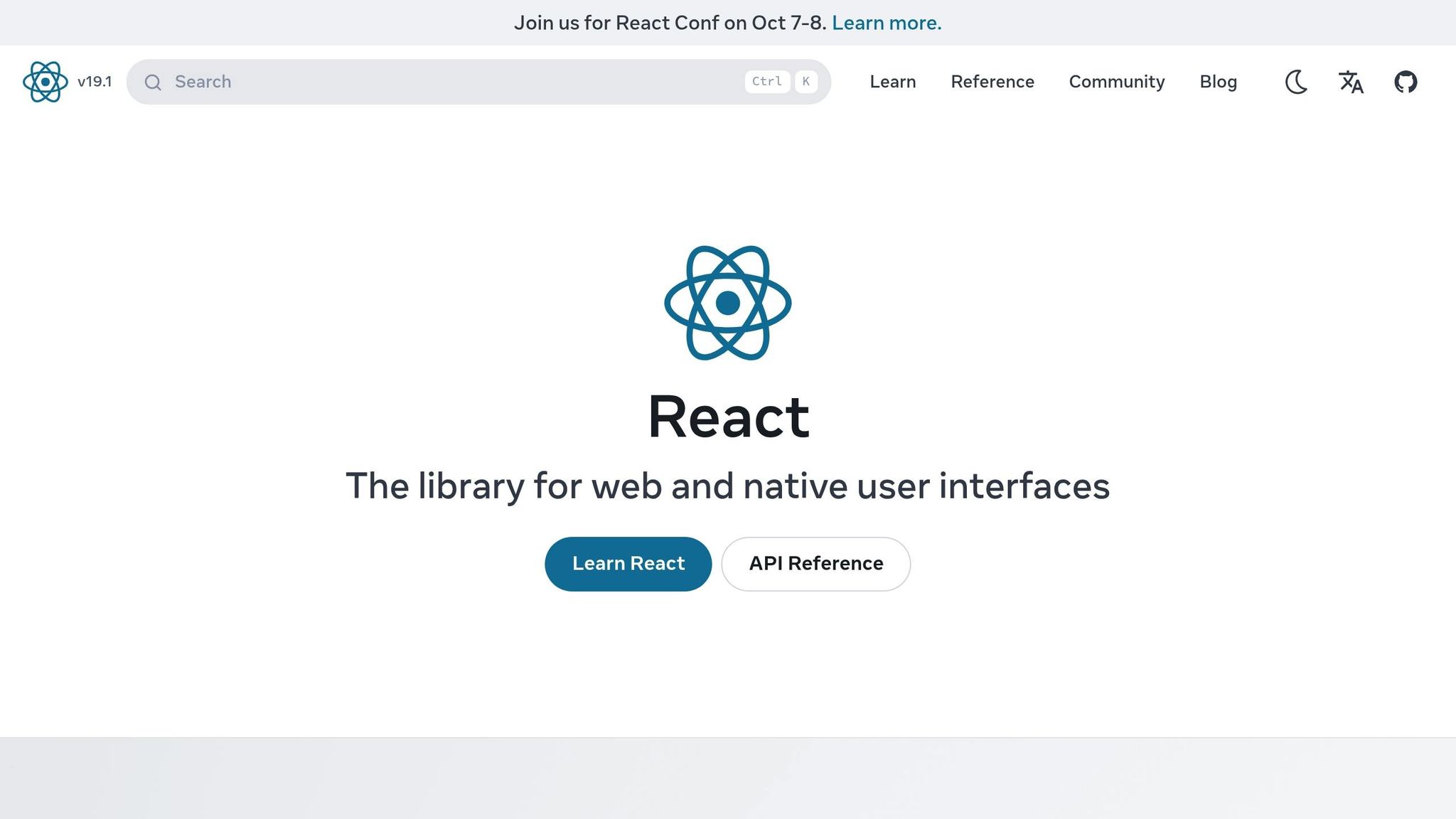

Want to convert your Figma designs into React components quickly and efficiently? Here's how tools like AI, MCP (Model-Driven Component Patterns), and CSS frameworks like MUI or Tailwind CSS can help you streamline the process.

| Feature | MUI | Tailwind CSS |
|---|---|---|
| Design Approach | Pre-built components | Utility-first classes |
| Customization | Theming options | Highly customizable |
| Learning Curve | Easier for React developers | Steeper initially |
| Performance | Larger library size | Leaner CSS bundles |
| Best For | Fast development, Material Design | Custom designs, performance tuning |

Preparing your Figma files properly is the first step toward smooth AI-powered conversion into React components. A cleanly structured design file can save you from hours of manual adjustments later. Think of it like building the blueprint for your code - your designs should reflect the way you'd structure your React components.
Start with consistent naming conventions. Every layer, frame, and component in your Figma file should have clear, descriptive names that align with React component naming. For example, use names like HeaderNavigation, ProductCard, or PrimaryButton. This helps both your team and AI tools understand the purpose of each element.
Group related elements using Figma’s frame structure to reflect the hierarchy of your React components. For instance, a UserProfile frame should include child elements like the avatar, name, bio, and action buttons.
Your component hierarchy in Figma should also match your intended React structure. Create a dedicated page for your design system components. This ensures consistency across your designs and makes it easier for AI tools to recognize reusable elements.
When exporting assets, stick to a naming convention that includes details like type, purpose, and size. Examples include icon-search-24px.svg or bg-hero-desktop.jpg. This consistency helps AI tools identify and apply these assets correctly during conversion.
Don’t overlook Auto Layout for responsive design. Configure Auto Layout settings to mimic CSS flexbox or grid behavior, ensuring that your designs translate into responsive React components seamlessly.
Once your Figma file is organized, you can begin mapping its elements directly to React components for a streamlined workflow.

With your file structure in place, the next step is to link design elements to their React counterparts. Use consistent naming and apply atomic design principles. Break down your designs into smaller, manageable pieces - starting with basic styles and colors, then building up to components, features, and full pages. This method allows for easy updates at the component level, which automatically cascade throughout the system.
Component mapping is key. Ensure that names in Figma match their React equivalents. This alignment reduces confusion and speeds up the conversion process.
"When designers and engineers speak the same language, there's less back-and-forth. What's in Figma is what's in code." - Lewis Healey
Leverage Figma variants to define different component states, such as hover, active, disabled, or loading. Use variant names that correspond to React props, making it easier for AI tools to generate accurate prop structures.
To bridge the gap between design and development, include documentation links directly in your Figma files. Add references to Storybook components, GitHub repositories, or other relevant resources. This extra context benefits both your team and AI tools, ensuring the intended implementation is clear.
Organize your Figma component library to mirror your React component categories, such as Navigation, Forms, or Data Display. This consistency simplifies collaboration and helps maintain clarity.
Once your files are organized and components mapped, it’s time to focus on accessibility and responsive settings.
Accessibility should be baked into your Figma designs from the start. Use proper color contrast ratios, ensure text is legible at various sizes, and define focus states for interactive elements.
Add accessibility annotations directly in your designs. Include details about tab order, ARIA labels, and keyboard navigation patterns. This documentation ensures that AI-generated code includes these accessibility features from the beginning.
"Make sure all annotations clearly show how components interact with tab index and other accessibility features. If it's defined in code, it should be reflected in Figma. This keeps designs usable and devs aligned." - Lewis Healey
For responsive design, use Figma’s constraint settings to define how elements should adapt to different screen sizes. Match your breakpoints to the ones in your CSS framework, such as MUI or Tailwind. Configure Auto Layout constraints to mimic CSS flexbox behavior, including settings like min-width, max-width, content wrapping, and spacing.
Test your designs at various viewport sizes directly in Figma. Create frames for mobile (375px), tablet (768px), and desktop (1440px) to ensure your constraints work as expected. Catching responsive issues early improves the quality of the React components generated.
Finally, document complex component behaviors. For example, if a dropdown menu should close when clicking outside or a modal should trap focus, include these details as comments or in your design documentation. These notes not only clarify your designs but also support efficient conversion into React.
Once your Figma files are neatly organized, the next step is using AI tools to convert those designs into functional React components. These tools not only ensure precision and consistency in design translation but also help you maintain the streamlined workflows you've already set up.
AI-powered plugins are a great way to bridge the gap between Figma designs and React code. One standout option is Builder.io's Visual Copilot, which generates static code while adapting to your existing tech stack. It supports multiple frameworks and offers styling options like Tailwind CSS, Emotion, and Styled Components.
If your project relies heavily on Material UI, QuestAI is a strong choice, as it focuses on integrating seamlessly with MUI components. On the other hand, DhiWise goes beyond code generation, aiming to automate the entire app development process.
These tools excel in understanding component hierarchies and creating reusable React components from Figma designs. They can even map Figma components to existing code structures, ensuring alignment with your design system. For instance, Visual Copilot uses AI models trained on over 2 million data points to transform flat designs into structured code hierarchies.
"Personally, I'm endlessly fascinated by every part of UI, from design through to implementation... I strongly recommend trying out Figma plugins to help accelerate your workflow. And if you are looking for a plugin to go from Figma to React/Tailwind (and lots of other variations), Visual Copilot is the best plugin I've seen for doing that work."
– Jack Herrington, Principal Full Stack Engineer and YouTuber
Although each tool has its own features, the overall workflow is similar. Start by installing your chosen plugin from the Figma plugin store. Once it's set up, the conversion process is straightforward.
For example, with Visual Copilot, you open the plugin within your Figma file, select the layer or component you want to convert, and click "Generate code." The tool analyzes your design and produces React code that you can directly integrate into your project. You can then tweak the code to add animations, custom fonts, or any unique functionality.
These tools can save a lot of time. In November 2024, Visual Copilot successfully converted a Figma design into fully responsive React/Tailwind code. It allowed users to toggle between desktop, tablet, and mobile previews, generating code that worked seamlessly across breakpoints. Users could also choose between frameworks and styling options, with an advanced "Quality" mode enhancing the code using GPT for better results.
Another benefit is the ability to refine the generated code with custom prompts. For instance, you could instruct the tool to replace standard <img> tags with Next.js's Image component for improved performance. Next, we'll dive into how Model-Driven Component Patterns can take AI-generated code to the next level.
While AI tools produce functional code, it often needs polishing to meet production standards. Think of the AI-generated output as a solid foundation rather than the final product.
Start by focusing on code organization. AI tools might create inline styles or overly complex structures, so break down larger components into smaller, reusable ones that align with your component library. If you're using TypeScript, refine the types, as the initial output may lack precision.
Performance is another key area to address. Look for opportunities to prevent unnecessary re-renders or improve state management. Tools like React.memo, useMemo, and useCallback can help optimize performance. Also, ensure list items have proper key props and optimize images for faster web delivery.
Accessibility often requires extra attention. While some tools include basic features, you may need to manually add ARIA labels, keyboard navigation, and focus management for more complex interactions.
These tools significantly reduce conversion time, allowing your team to focus on business logic and performance. At this stage, it's essential to integrate your design tokens - covering colors, spacing, typography, and more - to ensure consistency across your application and simplify future updates.
Finally, regular code reviews are crucial when working with AI-generated code. Set clear guidelines for acceptable output and provide templates or examples to illustrate your preferred coding standards and patterns. This ensures a smooth and efficient workflow while maintaining high-quality results.
Model-Driven Component Patterns (MCP) offers a fresh approach to UI development. Instead of treating design context as fixed data, MCP creates a dynamic system where AI tools can understand and adapt to intricate component relationships. This ensures accurate design-to-code handoffs while maintaining consistency and scalability across projects.
By building on AI-powered code conversion, MCP refines and standardizes the design-to-code workflow.
Developing effective component models starts with establishing a clear structure and well-defined APIs that both humans and AI can easily interpret. Use consistent design tokens - such as colors, spacing, typography, and interaction states - to help AI tools generate code that aligns seamlessly with your design system.
Component mapping acts as a persistent link between design updates and React components, significantly reducing the need for manual adjustments. To streamline this process, organize component models around common UI patterns by creating templates for elements like buttons, forms, navigation components, and layouts. Each template should clearly define the component API, including props, variants, and tokens, to ensure consistent and scalable implementations.
Detailed documentation is key. Include clear prop definitions, usage examples, and variant specifications to help both team members and AI systems understand and apply the component API effectively.
MCP enables AI systems to grasp the complete design context, allowing them to generate components that integrate seamlessly into your architecture.
"The biggest challenge is aligning the component 'API' (props, variants, tokens) between design and code. As Nathan Curtis points out, co-creating a shared API requires active collaboration between designers and developers from the beginning."
Start by training your AI tools with examples from your current component library. Many modern conversion tools let you provide structured code samples that reflect your team's coding standards and design principles. MCP-equipped systems can dynamically interpret the context of your components. For example, they can adjust the behavior of a button based on whether it’s used in a form, navigation menu, or call-to-action, modifying its styling and functionality accordingly.
MCP works seamlessly with AI frameworks like Visual Copilot, CopilotKit, and custom AI agents. These tools use MCP to share a standardized understanding of your design system. A practical example is the integration of MCP servers to connect Figma designs with your React codebase. The MCP Figma to React Converter can automatically pull design specifications and generate TypeScript components styled with Tailwind CSS classes that match your configuration. This automation minimizes manual translation efforts while ensuring alignment with your design patterns.
To get the most out of MCP, encourage close collaboration between designers and developers from the start. This helps keep component APIs aligned across Figma, code, and documentation. Regularly reviewing AI-generated components ensures quality and highlights areas for improvement. Think of MCP as a continuously evolving framework that improves how AI interprets your design system, creating a feedback loop that drives ongoing refinement.

2V AI DevBoost takes the concept of AI-driven workflows to the next level, offering customized strategies to streamline your design-to-code process. By focusing on optimizing Figma-to-React workflows, they tackle one of the most time-consuming aspects of development: translating Figma designs into functional React code, a task that can take developers days to complete.
The process begins with a detailed audit of your design-to-code workflow. 2V AI DevBoost examines how your team uses Figma, identifies bottlenecks in component handling, and evaluates your existing React setup, whether you're using tools like MUI or Tailwind CSS.
This analysis digs into the specifics of your team's operations - everything from your design systems and coding standards to how designers and developers collaborate. By understanding these details, the consultancy identifies the AI tools that will fit seamlessly into your workflow and highlights where MCP (Model-Conditioned Prompting) patterns can make the biggest difference.
A key part of the audit is assessing how well your current processes support training AI systems with your code samples, ensuring the generated code matches your team's unique style and standards. This step lays the groundwork for incorporating MCP patterns that adapt dynamically to your design system.
After the audit, you’ll receive a comprehensive roadmap tailored to your team. It includes specific, actionable recommendations for AI tools, workflow adjustments, and MCP integration. The roadmap is designed for a step-by-step implementation, helping your team adopt changes in a manageable way rather than overhauling everything at once. This detailed plan also determines the most appropriate pricing tier for your needs.
To accommodate teams of various sizes, 2V AI DevBoost offers a tiered pricing model. Each tier reflects the complexity of optimizing workflows for different team configurations.
| Team Size | Price | Team Range | Service Scope |
|---|---|---|---|
| Small Team | $10,000 | 5-10 people | Workflow audit, tool recommendations, and implementation support |
| Medium Team | $20,000 | 11-30 people | Enhanced coordination, streamlined workflows, and advanced MCP integration |
| Large Team | $30,000 | 31-50 people | Complex organizational alignment and enterprise tool integration |
| Enterprise Team | $40,000 | 51-100 people | Comprehensive transformation, advanced customization, and executive reporting |
Each tier includes the same foundational services, with pricing adjusted based on the added complexity of working with larger teams and the need for more extensive customization at the enterprise level.
For US-based teams, it’s worth considering the Total Cost of Ownership (TCO) alongside the initial investment. Properly implemented AI workflows can lead to significant time savings and better-quality code, making the upfront cost worthwhile. Additionally, teams should evaluate the Return on Investment (ROI) from faster design-to-code cycles and less manual effort.
Unlike subscription models, this is a one-time service, making it easier to budget and assess long-term benefits. For teams looking for ongoing improvements, 2V AI DevBoost also provides retainer options to keep workflows updated as AI tools and MCP methods evolve.
When choosing a pricing tier, focus on your team’s day-to-day needs rather than planning for a theoretical maximum capacity. For example, a medium-sized team with close collaboration might find the $20,000 tier more beneficial than a larger, distributed team that requires the broader organizational strategies offered at the $30,000 level.
When developing AI-powered Figma-to-React workflows, choosing the right CSS framework can streamline your process. MUI and Tailwind CSS offer distinct approaches to styling, each with unique advantages that influence how they integrate with AI tools.
Tailwind CSS has impressive adoption stats, with over 3.1 million NPM installs, 53,000 active projects, and 460 components. Let’s break down how these frameworks compare in key areas relevant to AI-driven workflows.
Understanding the core differences between MUI and Tailwind CSS is essential for selecting the right tool for your project. Here's a quick look at their key features:
| Feature | MUI | Tailwind CSS |
|---|---|---|
| Design Approach | Component-first with pre-built styled components | Utility-first with low-level utility classes |
| Customization Level | Theming options based on Material Design | Highly customizable with detailed control |
| Development Speed | Faster initial setup with ready-to-use components | Quick prototyping via utility classes |
| Learning Curve | Easier for React developers | Steeper learning curve initially |
| Performance | Optimized components but larger library size | Smaller CSS bundles by removing unused styles |
| AI Integration | Standardized, consistent outputs | Flexible for unique, custom designs |
MUI offers pre-built components that align with Google’s Material Design principles. For example, AI tools like UXPin's AI Component Creator can generate MUI components directly from open-source libraries, delivering fully functional UI elements.
On the other hand, Tailwind CSS shines in customization and performance. Its utility-first approach allows for granular control, making it ideal for creating highly tailored designs. Additionally, Tailwind’s ability to purge unused styles helps reduce CSS bundle sizes, which is particularly valuable for large-scale applications that demand fast load times and strong SEO performance.
Both frameworks can also work together. By combining MUI’s robust component library with Tailwind’s utility-first styling, teams can achieve a balance of functionality and visual precision. This hybrid approach is especially useful for AI workflows, enabling rapid styling alongside pre-built component functionality.
Deciding between MUI and Tailwind CSS depends on your team’s priorities, skills, and project requirements.
For teams in the United States, a hybrid strategy can be highly effective. Use Tailwind for layout and basic styling, while leveraging MUI for more complex components. This approach ensures consistency with Figma designs while combining the strengths of both frameworks.
Start small by testing these frameworks on targeted projects. Experiment with prompting strategies and assess how well each framework integrates with your AI tools. This thoughtful approach will help you determine the best fit for your workflow, ensuring a smooth transition from design to production-ready React components.
Turning Figma designs into React code using tools like MUI, Tailwind CSS, and AI-powered solutions has reshaped how development teams handle design-to-code workflows. By combining well-organized Figma files, AI automation, and Model-Driven Component Patterns (MCP), teams can streamline their processes, maintain design consistency, and significantly boost productivity.
This isn’t just about converting designs into code - it’s about tailoring them to fit seamlessly into your codebase. As Builder.io aptly puts it:
"Going from Figma to code should not just be about translating designs into code; it should be about translating them into your code."
The real power of this approach emerges when MCP links AI tools directly to your design systems. For instance, Standard Beagle Studio used MCP to connect their project management tool with their coding engine. This allowed AI to pull component data straight from finalized Figma mockups, generating code efficiently.
For development teams in the U.S., the productivity gains from this approach are hard to ignore. Teams have reported efficiency improvements ranging from 15% to 200%, depending on how deeply they integrate these strategies into their workflows.
To make the most of Figma-to-React conversion with AI, you’ll need to focus on a few critical steps:
For teams ready to dive deeper, 2V AI DevBoost offers tailored support for optimizing workflows. Their 5-week AI productivity sprint includes process audits, tool recommendations, and hands-on implementation. Small teams (5–10 people) can expect pricing around $10,000, while enterprise teams (51–100 people) may invest up to $40,000. Many report that the investment quickly pays off in faster development cycles and reduced friction during design-to-code transitions.
Looking ahead, MCP should be treated as a foundational part of your workflow infrastructure. By focusing on security, scalability, and seamless integration with AI tools, teams can stay ahead of the curve. Those who embrace these strategies today will be well-positioned to leverage the rapid evolution of AI-driven development tools while maintaining the high standards of design consistency and code quality that modern applications demand.
Model-Driven Component Patterns (MCP) offer a structured way to bring consistency and scalability to design-to-code workflows. By integrating AI models directly with your tools and systems, MCP creates a seamless framework for building and managing components.
Rooted in Domain-Driven Design principles, MCP ensures that components are built to be reusable and easy to maintain, even as your project evolves. This approach reduces repetitive tasks, enhances team collaboration, and simplifies the management of complex workflows. With MCP, you can expand your processes efficiently while keeping both design precision and development productivity intact.
When deciding between MUI and Tailwind CSS to convert Figma designs into React using AI tools, your choice will hinge on your project's specific needs and priorities.
If your focus is on customization and adaptability, Tailwind CSS might be the better fit. Its utility-first approach gives you the freedom to craft highly specific designs, making it a strong choice for AI-driven workflows that demand unique and dynamic interfaces. Meanwhile, MUI stands out for its pre-designed, ready-to-use components. These can save you time and ensure a consistent look and feel across your project, which is especially helpful when using AI tools to generate clean, uniform code.
In short, go with Tailwind CSS if flexibility and customization are your top priorities. Opt for MUI if speed and consistent design are what you need most.
To make AI-generated React components more accessible, it's crucial to include ARIA roles, keyboard navigation, and proper focus management. These features ensure your app is usable by everyone, including individuals with disabilities. Additionally, tools designed to detect WCAG violations can help pinpoint and address accessibility issues, improving screen reader compatibility and meeting accessibility standards.
For responsive design, rely on dynamic styling and media queries to adjust components for various screen sizes. Focus on creating flexible layouts and scalable design elements to deliver a smooth experience across different devices. Combining these approaches ensures your components are inclusive and responsive, adhering to today's design and development standards.